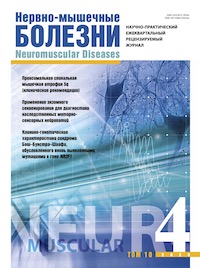Proximal spinal muscular atrophy 5q
- Issue: Vol 10, No 4 (2020)
- Pages: 53-104
- Section: CLINICAL RECOMMENDATIONS
- Published: 29.12.2020
- URL: https://nmb.abvpress.ru/jour/article/view/408
- DOI: https://doi.org/undefined
- ID: 408
Cite item
Full Text
Abstract
.
References
Supplementary files







